[转载] 优先级反转那些事儿
1. 从一个线上问题说起
最近在线上遇到了一些[HMDConfigManager remoteConfigWithAppID:]卡死
1.1 初步分析
观察了下主线程堆栈,用到的锁是读写锁:

随后又去翻了下持有着锁的子线程,有各种各样的情况,且基本都处于正常的执行状态,例如有的处于打开文件状态,有的处于read状态,有的正在执行NSUserDefaults的方法···


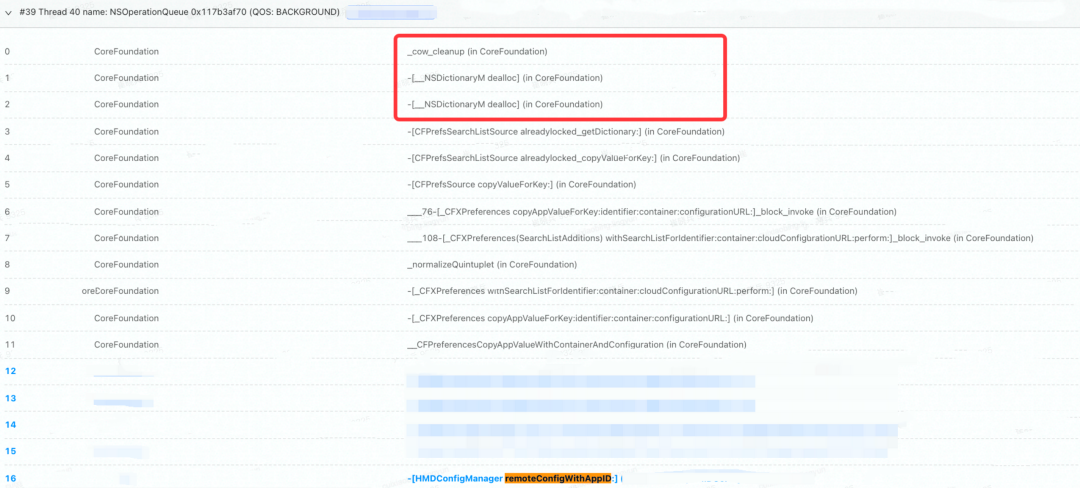
通过观察发现,出问题的线程都有QOS:BACKGROUND标记。整体看起来持有锁的子线程仍然在执行,只是留给主线程的时间不够了。为什么这些子线程在持有锁的情况下,需要执行这么久,直到主线程的 8s 卡死?一种情况就是真的如此耗时,另一种则是出现了优先级反转。
1.2 解决办法
这个案例里,持有读写锁且优先级低的线程迟迟得不到调度(又或者得到调度的时候又被抢占了,或者得到调度的时候时间已然不够了)而具有高优先级的线程由于拿不到读写锁,一直被阻塞,所以互相死锁。iOS8之后引入了QualityOfService的概念,类似于线程的优先级,设置不同的QualityOfService的值后系统会分配不同的CPU时间、网络资源和硬盘资源等,因此我们可以通过这个设置队列的优先级。
1.2.1方案一:去除对 NSOperationQueue 的优先级设置
在 Threading Programming Guide 文档中,苹果给出了提示:
Important: It is generally a good idea to leave the priorities of
your threads at their default values. Increasing the priorities of
some threads also increases the likelihood of starvation among
lower-priority threads. If your application contains high-priority and
low-priority threads that must interact with each other, the
starvation of lower-priority threads may block other threads and
create performance bottlenecks.
苹果的建议是不要随意修改线程的优先级,尤其是这些高低优先级线程之间存在临界资源竞争的情况。所以删除相关优先级设置代码即可解决问题。
1.2.2 方案二:临时修改线程优先级
在 pthread_rwlock_rdlock(3pthread) 发现了如下提示:
Realtime applications may encounter priority inversion when using
read-write locks. The problem occurs when a high priority thread
“locks” a read-write lock that is about to be “unlocked” by a low
priority thread, but the low priority thread is preempted by a medium
priority thread. This scenario leads to priority inversion; a high
priority thread is blocked by lower priority threads for an unlimited
period of time. During system design, realtime programmers must take
into account the possibility of this kind of priority inversion.
They can deal with it in a number of ways, such as by having
critical sections that are guarded by read-write locks execute at a
high priority, so that a thread cannot be preempted while executing in
its critical section.
尽管针对的是实时系统,但是还是有一些启示和帮助。按照提示,对有问题的代码进行了修改: 在线程通过 pthread_rwlock_wrlock 拿到 _rwlock 的时候,临时提升其优先级,在释放 _rwlock 之后,恢复其原先的优先级。
1 | - (id)remoteConfigWithAppID:(NSString *)appID |
值得注意的是,这里只能使用pthread的api,NSThread提供的API是不可行的
1.3 Demo 验证
为了验证上述的手动调整线程优先级是否有一定的效果,这里通过demo进行本地实验:定义了2000个operation(目的是为了CPU繁忙),优先级设置NSQualityOfServiceUserInitiated,且对其中可以被100整除的operation的优先级调整为NSQualityOfServiceBackground,在每个operation执行相同的耗时任务,然后对这被选中的10个operation进行耗时统计。
1 | for (int j = 0; j < 2000; ++j) { |
统计信息如下表所示:

可以看到:
- 正常情况下,每个任务的平均耗时为:11.8190561;
- 当
operation被设置为低优先级时,其耗时大幅度提升为:94.70210189; - 当
operation被设置为低优先级时,又在Block中手动恢复其原有的优先级,其耗时已经大幅度降低:15.04005137(耗时比正常情况高,大家可以思考下为什么)
通过Demo可以发现,通过手动调整其优先级,低优先级任务的整体耗时得到大幅度的降低,这样在持有锁的情况下,可以减少对主线程的阻塞时间。
1.4 上线效果

该问题的验证过程分为2个阶段:
- 第一个阶段如第1个红框所示,从3月6号开始在版本19.7上有较大幅度的下降,主要原因:堆栈中被等待的队列信息由
QOS:BACKGROUND变为了com.apple.root.default-qos,队列的优先级从QOS_CLASS_BACKGROUND提升为QOS_CLASS_DEFAULT,相当于实施了方案一,使用了默认优先级。 - 第二个阶段如第2个红框所示,从4月24号在版本20.3上开始验证。目前看起来效果暂时不明显,推测一个主要原因是:demo中是把优先级从
QOS_CLASS_BACKGROUND提升为QOS_CLASS_USER_INITIATED,而线上相当于把队列的优先级从默认的优先级QOS_CLASS_DEFAULT提升为QOS_CLASS_USER_INITIATEDQOS_CLASS_BACKGROUND的Mach层级优先级数是4;QOS_CLASS_DEFAULT的Mach层级优先级数是31;QOS_CLASS_USER_INITIATED的Mach层级优先级数是37。
所以相对来说,线上的提升相对有限。
2. 深刻理解优先级反转
那么是否所有锁都需要像上文一样,手动提升持有锁的线程优先级?系统是否会自动调整线程的优先级?如果有这样的机制,是否可以覆盖所有的锁?要理解这些问题,需要深刻认识优先级反转。
2.1 什么是优先级反转?
优先级反转,是指某同步资源被较低优先级的进程/线程所拥有,较高优先级的进程/线程竞争该同步资源未获得该资源,而使得较高优先级进程/线程反而推迟被调度执行的现象。根据阻塞类型的不同,优先级反转又被分为Bounded priority inversion和Unbounded priority inversion。
这里借助 Introduction to RTOS - Solution to Part 11 的图进行示意。
2.1.1 Bounded priority inversion
如图所示,高优先级任务(Task H)被持有锁的低优先级任务(Task L)阻塞,由于阻塞的时间取决于低优先级任务在临界区的时间(持有锁的时间),所以被称为bounded
priority inversion。只要Task L一直持有锁,Task H就会一直被阻塞,低优先级的任务运行在高优先级任务的前面,优先级被反转。
这里的任务也可以理解为线程
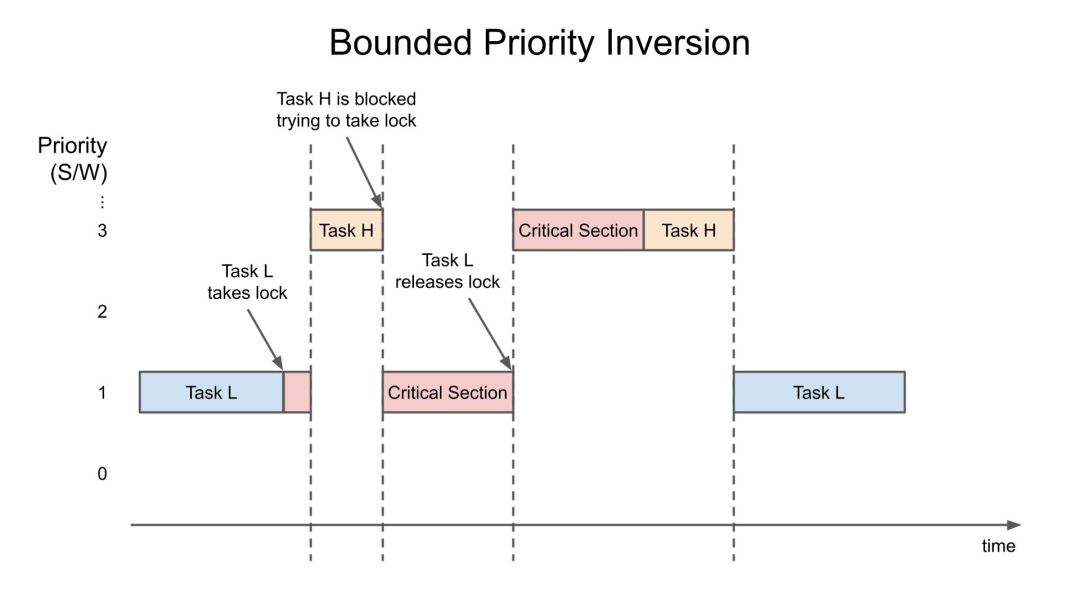
2.1.2 Unbounded priority inversion
在Task L持有锁的情况下,如果有一个中间优先级的任务(Task M)打断了Task L,前面的bounded就会变为unbounded,因为Task M只要抢占了Task L的CPU,就可能会阻塞Task H任意多的时间(Task M可能不止1个)。
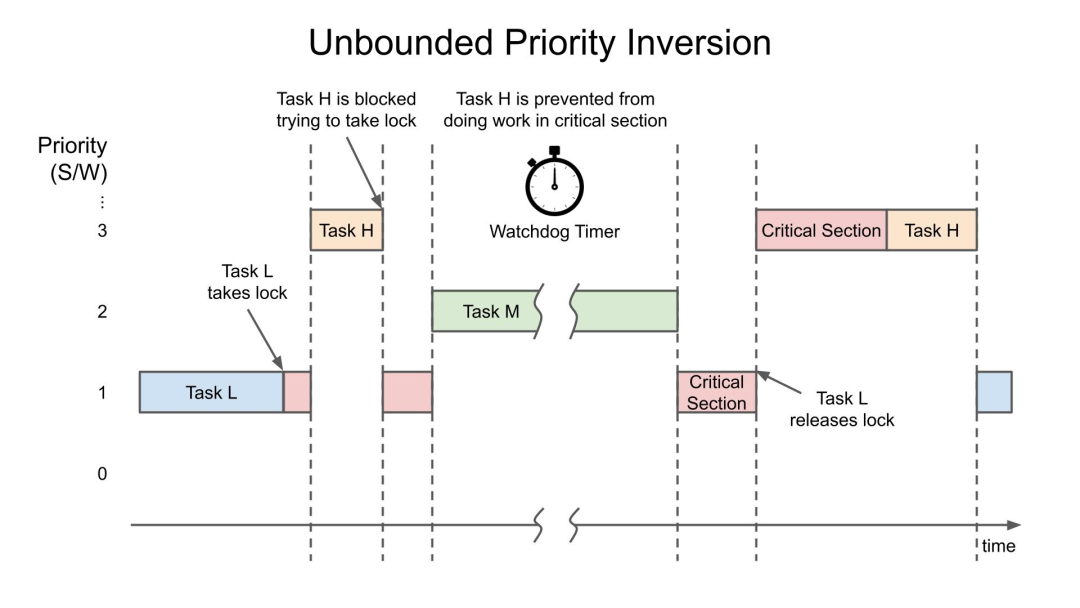
2.2 优先级反转常规解决思路
目前解决Unbounded priority inversion有2种方法:一种被称作优先权极限(priority ceiling protocol),另一种被称作优先级继承(priority inheritance)。
2.2.1 Priority ceiling protocol
在优先权极限方案中,系统把每一个临界资源与 1 个极限优先权相关联。当1个任务进入临界区时,系统便把这个极限优先权传递给这个任务,使得这个任务的优先权最高;当这个任务退出临界区后,系统立即把它的优先权恢复正常,从而保证系统不会出现优先权反转的情况。该极限优先权的值是由所有需要该临界资源的任务的最大优先级来决定的。
如图所示,锁的极限优先权是 3。当Task L持有锁的时候,它的优先级将会被提升到3,和Task H一样的优先级。这样就可以阻止Task M(优先级是2)的运行,直到Task L和Task H不再需要该锁。
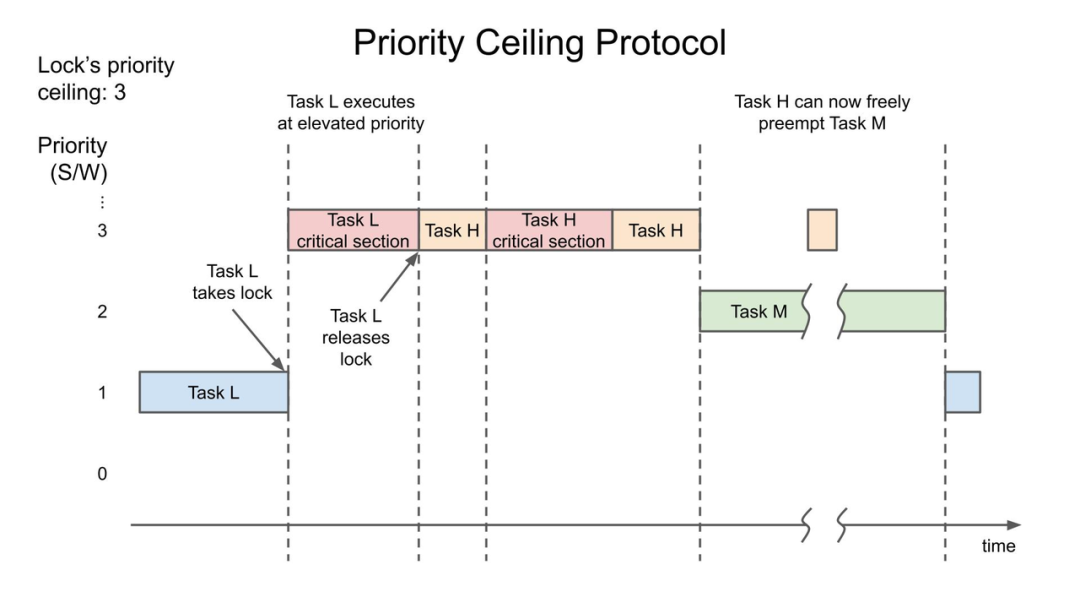
2.2.2 Priority inheritance
在优先级继承方案中,大致原理是:高优先级任务在尝试获取锁的时候,如果该锁正好被低优先级任务持有,此时会临时把高优先级线程的优先级转移给拥有锁的低优先级线程,使低优先级线程能更快的执行并释放同步资源,释放同步资源后再恢复其原来的优先级。
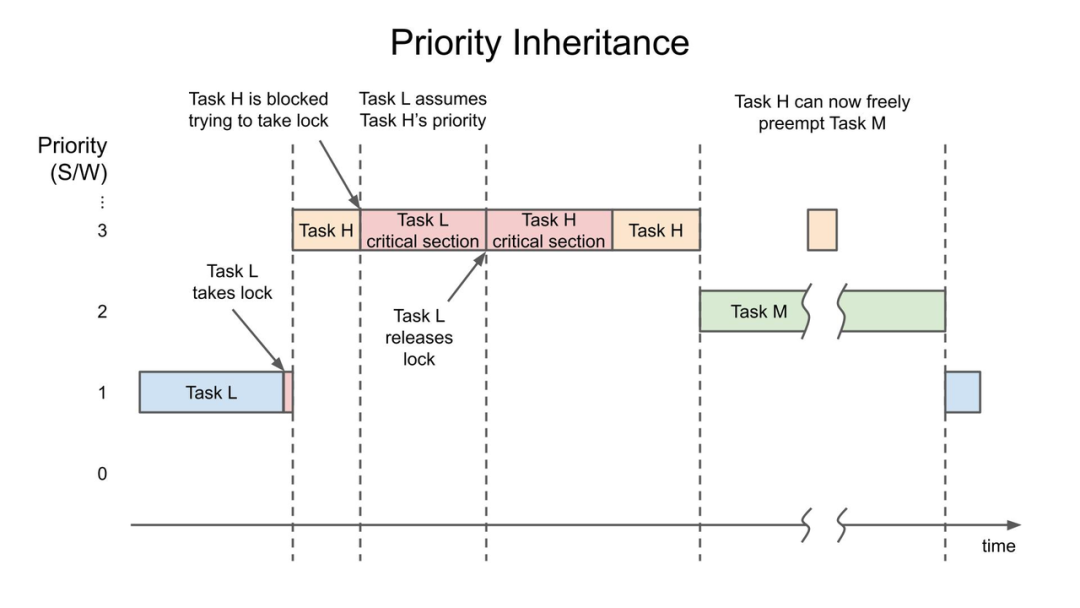
priority ceiling protocol和priority inheritance都会在释放锁的时候,恢复低优先级任务的优先级。同时要注意,以上2种方法只能阻止Unbounded priority inversion,而无法阻止Bounded priority inversion(Task H必须等待Task L执行完毕才能执行,这个反转是无法避免的)。
可以通过以下几种发生来避免或者转移Bounded priority inversion:
- 减少临界区的执行时间,减少
Bounded priority inversion的反转耗时; - 避免使用会阻塞高优先级任务的临界区资源;
- 专门使用一个队列来管理资源,避免使用锁。
优先级继承必须是可传递的。举个栗子:当
T1阻塞在被T2持有的资源上,而T2又阻塞在T3持有的一个资源上。如果T1的优先级高于T2和T3的优先级,T3必须通过T2继承T1的优先级。否则,如果另外一个优先级高于T2和T3,小于T1的线程T4,将抢占T3,引发相对于T1的优先级反转。因此,线程所继承的优先级必须是直接或者间接阻塞的线程的最高优先级。
3. 如何避免优先级反转?
3.1 QoS 传递
iOS 系统主要使用以下两种机制来在不同线程(或 queue)间传递 QoS:
机制 1:
dispatch_asyncdispatch_async()automatically propagates the QoS from the calling thread, though it will translate User Interactive to User Initiated to avoid assigning that priority to non-main threads.- Capturedattimeofblocksubmission, translateuserinteractivetouserinitiated. UsedifdestinationqueuedoesnothaveaQoSanddoesnotlowertheQoS(exdispatch_asyncbacktothemainthread).
机制 2:基于 XPC 的进程间通信(
IPC) 系统的 QoS 传递规则比较复杂,主要参考以下信息:当前线程的
QoS如果是使用
dispatch_block_create()方法生成的dispatch_block,则考虑生成block时所调用的参数dispatch_async或IPC的目标queue或线程的QoS
调度程序会根据这些信息决定 block 以什么优先级运行。
- 如果没有其他线程同步地等待此
block,则block就按上面所说的优先级来运行。 - 如果出现了线程间同步等待的情况,则调度程序会根据情况调整线程的运行优先级。
3.2 如何触发优先级反转避免机制?
如果当前线程因等待某线程(线程 1)上正在进行的操作(如 block1)而受阻,而系统知道 block1 所在的目标线程(owner),系统会通过提高相关线程的优先级来解决优先级反转的问题。反之如果系统不知道 block1 所在目标线程,则无法知道应该提高谁的优先级,也就无法解决反转问题;
记录了持有者信息(owner)的系统 API 如下:
pthread mutex、os_unfair_lock、以及基于这二者实现的上层APIa.
dispatch_once的实现是基于os_unfair_lock的b.
NSLock、NSRecursiveLock、@synchronized等的实现是基于
pthreadmutex
2. dispatch_sync、dispatch_wait
3. xpc_connection_send_with_message_sync
使用以上这些 API 能够在发生优先级反转时使系统启用优先级反转避免机制。
3.3 基础 API 验证
接下来对前文提到的各种「基础系统API」进行验证
测试验证环境:模拟器 iOS15.2
3.3.1 pthread mutex
pthread mutex 的数据结构pthread_mutex_s其中有一个m_tid字段,专门来记录持有该锁的线程Id。
1 | // types_internal.h |
代码来验证一下:线程优先级是否会被提升?
1 | // printThreadPriority用来打印线程的优先级信息 |
先在子线程上锁并休眠,然后主线程请求该锁。
1 | dispatch_async(dispatch_get_global_queue(DISPATCH_QUEUE_PRIORITY_BACKGROUND, 0), ^{ |
1 | begin : |
可以看到,低优先级子线程先持有锁,当时的优先级为4,而该锁被主线程请求的时候,子线程的优先级被提升为47
3.3.2 os_unfair_lock
os_unfair_lock用来替换OSSpinLock,解决优先级反转问题。等待os_unfair_lock锁的线程会处于休眠状态,从用户态切换到内核态,而并非忙等。os_unfair_lock将线程ID保存到了锁的内部,锁的等待者会把自己的优先级让出来,从而避免优先级反转。验证一下:
1 | dispatch_async(dispatch_get_global_queue(DISPATCH_QUEUE_PRIORITY_BACKGROUND, 0), ^{ |
1 | begin : |
结果和pthread mutex一致。
3.3.3 pthread_rwlock_t
在 pthread_rwlock_init 有如下提示:
Caveats: Beware of priority inversion when using read-write
locks. A high-priority thread may be blocked waiting on a read-write
lock locked by a low-priority thread. The microkernel has no knowledge
of read-write locks, and therefore can’t boost the low-priority
thread to prevent the priority inversion.
大意是内核不感知读写锁,无法提升低优先级线程的优先级,从而无法避免优先级反转。通过查询定义发现:pthread_rwlock_s包含了字段rw_tid,专门来记录持有写锁的线程,这不由令人好奇:为什么pthread_rwlock_s有owner信息却仍然无法避免优先级反转?
1 | struct pthread_rwlock_s { |
https://news.ycombinator.com/item?id=21751269 链接中提到:
xnu supports priority inheritance through “turnstiles“, a
kernel-internal mechanism which is used by default by a number of
locking primitives (list at [1]), including normal pthread mutexes
(though not read-write locks [2]), as well as the os_unfair_lock API
(via the ulock syscalls). With pthread mutexes, you can actually
explicitly request priority inheritance by calling
pthread_mutexattr_setprotocol [3] with PTHREAD_PRIO_INHERIT; the
Apple implementation supports it, but currently ignores the protocol
setting and just gives all mutexes priority inheritance.
大意是:XNU使用 turnstiles 内核机制进行优先级继承,这种机制被应用在 pthread mutex 和 os_unfair_lock 上。
顺藤摸瓜,在ksyn_wait方法中找到了_kwq_use_turnstile的调用,其中的注释对读写锁解释的比较委婉,添加了 at least sometimes
pthread mutexes and rwlocks both (at least sometimes) know their
owner and can use turnstiles. Otherwise, we pass NULL as the tstore to
the shims so they wait on the global waitq.
1 | // libpthread/kern/kern_synch.c |
再去查看_kwq_use_turnstile的定义,代码还是很诚实的,只有在KSYN_WQTYPE_MTX才会启用turnstile进行优先级反转保护,而读写锁的类型为KSYN_WQTYPE_RWLOCK,这说明读写锁不会使用_kwq_use_turnstile,所以无法避免优先级反转。
1 |
|
另外在_pthread_find_owner也可以看到,读写锁的owner是0
1 | void _pthread_find_owner(thread_t thread, struct stackshot_thread_waitinfo * waitinfo) |
把锁更换为读写锁,验证一下前面的理论是否正确:
1 | pthread_rwlock_init(&_rwlock, NULL); |
1 | begin : |
可以看到读写锁不会发生优先级提升。
3.3.4 dispatch_sync
这个API都比较熟悉了,这里直接验证:
1 | // 当前线程为主线程 |
1 | pth_priority: 47, pth_curpri: 47, pth_maxpriority: 63 |
_queue是一个低优先级队列(QOS_CLASS_BACKGROUND),可以看到dispatch_sync调用压入队列的任务,以及在这之前dispatch_async压入的任务,都被提升到较高的优先级47(和主线程一致),而最后一个dispatch_async的任务则以优先级4来执行。
3.3.5 dispatch_wait
1 | // 当前线程为主线程 |
_queue是一个低优先级队列(QOS_CLASS_BACKGROUND),当在当前主线程使用dispatch_wait进行等待时,输出如下,低优先级的任务被提升到优先级47
1 | main thread |
而如果将dispatch_wait(block, DISPATCH_TIME_FOREVER)注释掉之后,输出如下:
1 | main thread |
值得注意的是,
dispatch_wait是一个宏(C11的泛型),或者是一个入口函数,它可以接受dispatch_block_t,dispatch_group_t,dispatch_semaphore_t
3种类型的参数,但是这里的具体含义应该是指dispatch_block_wait,只有dispatch_block_wait会调整优先级,避免优先级反转。
1 | intptr_t |
3.4 神秘的信号量
3.4.1 dispatch_semaphore
之前对dispatch_semaphore的认知非常浅薄,经常把二值信号量和互斥锁划等号。但是通过调研后发现:dispatch_semaphore 没有 QoS 的概念,没有记录当前持有信号量的线程(owner),所以有高优先级的线程在等待锁时,内核无法知道该提高哪个线程的调试优先级(QoS)。如果锁持有者优先级比其他线程低,高优先级的等待线程将一直等待。Mutexvs Semaphore: What’s the Difference? 一文详细比对了Mutex和Semaphore之间的区别。
Semaphores are for signaling (sames a condition variables, events)
while mutexes are for mutual exclusion. Technically, you can also
use semaphores for mutual exclusion (a mutex can be thought as a
binary semaphore) but you really shouldn’t.
Right, but libdispatch doesn’t have a mutex. It has semaphores and
queues. So if you’re trying to use libdispatch and you don’t want
the closure-based aspect of queues, you might be tempted to use a
semaphore instead. Don’t do that, use os_unfair_lock or
pthread_mutex (or a higher-level construct like NSLock) instead.
这些是一些警示,可以看到dispatch_semaphore十分危险,使用需要特别小心。
这里通过苹果官方提供的demo进行解释:
1 | __block NSString *taskName = nil; |
- 假设在主线程执行这段代码,那么当前线程的优先级是
QOS_CLASS_USER_INTERACTIVE; - 由于从主线程进行了异步,异步任务队列的
QoS将会被提升为QOS_CLASS_USER_INITIATED; - 主线程被信号量
sema阻塞,而负责释放该信号量的异步任务的优先级QOS_CLASS_USER_INITIATED低于主线程的优先级QOS_CLASS_USER_INTERACTIVE,因此可能会发生优先级反转。
值得一提的是,Clang专门针对这种情况进行了静态检测
1 | static auto findGCDAntiPatternWithSemaphore() -> decltype(compoundStmt()) { |
如果想使用该功能,只需要打开xcode设置即可:
另外,
dispatch_group跟semaphore类似,在调用enter()方法时,无法预知谁会调用leave(),所以系统也无法知道其owner是谁,所以同样不会有优先级提升的问题。
3.4.2 信号量卡死现身说法
dispatch_semaphore给笔者的印象非常深刻,之前写过一段这样的代码:使用信号量在主线程同步等待相机授权结果。
1 | __block BOOL auth = NO; |
上线后长期占据卡死top1,当时百思不得其解,在深入了解到信号量无法避免优先级反转后,终于豁然开朗,一扫之前心中的阴霾。

这类问题一般通过2种方式来解决:
使用同步API
1
2
3BOOL auth = [KTAuthorizeService authorizationWithType:KTPermissionsTypeCamera];
// do something next异步回调,不要在当前线程等待
1
2
3
4
5
6
7[KTAuthorizeService requestAuthorizationWithType:KTPermissionsTypeCamera completionHandler:^(BOOL allow) {
BOOL auth = allow;
// do something next via callback
}];
4. 几个概念
4.1 turnstile
前文提到XNU使用turnstile进行优先级继承,这里对turnstile机制进行简单的描述和理解。在XNU内核中,存在着大量的同步对象(例如lck_mtx_t),为了解决优先级反转的问题,每个同步对象都必须对应一个分离的数据结构来维护大量的信息,例如阻塞在这个同步对象上的线程队列。可以想象一下,如果每个同步对象都要分配一个这样的数据结构,将造成极大的内存浪费。
为了解决这个问题,XNU采用了turnstile机制,一种空间利用率很高的解决方案。该方案的提出依据是同一个线程在同一时刻不能同时阻塞于多个同步对象上。这一事实允许所有同步对象只需要保留一个指向turnstile的指针,且在需要的时候去分配一个turnstile即可,而turnstile则包含了操作一个同步对象需要的所有信息,例如阻塞线程的队列、拥有这个同步对象的线程指针。turnstile是从池中动态分配的,这个池的大小会随着系统中已分配的线程数目增加而增加,所以turnstile总数将始终低于或等于线程数,这也决定了turnstile的数目是可控的。turnstile由阻塞在该同步对象上的第一个线程负责分配,当没有更多线程阻塞在该同步对象上,turnstile会被释放,回收到池中。
turnstile的数据结构如下:
1 |
|
4.2 优先级数值
在验证环节有一些优先级数值,这里借助「Mac OS® X and iOS Internals」解释一下:实验中涉及到的优先级数值都是相对于Mach层而言的,且都是用户线程数值。
- 用户线程的优先级是0~63;
NSQualityOfServiceBackground的Mach层级优先级数是4;NSQualityOfServiceUtility的Mach层级优先级数是20;NSQualityOfServiceDefault的Mach层级优先级数是31;NSQualityOfServiceUserInitiated的Mach层级优先级数是37;NSQualityOfServiceUserInteractive的Mach层级优先级是47。
- 内核线程的优先级是80~95;
- 实时系统线程的优先级是96~127;
- 64~79被保留给系统使用。
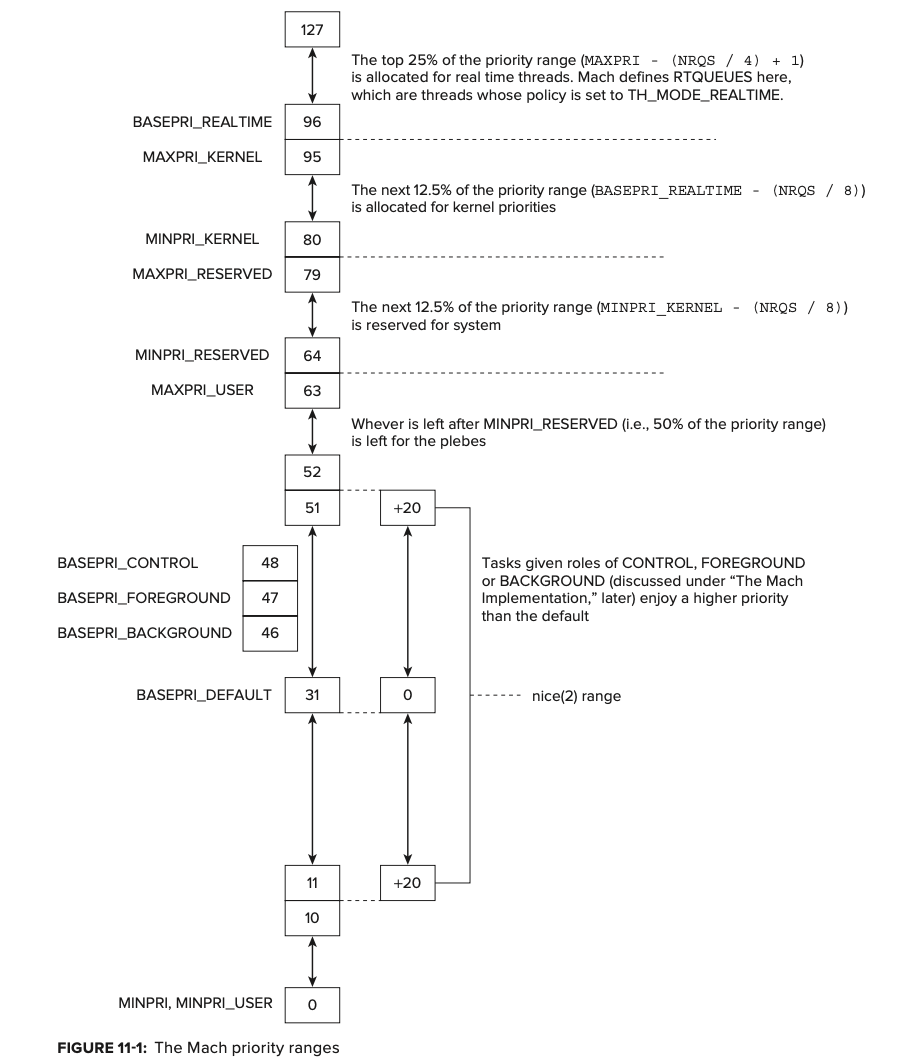
5. 总结
本文主要阐述了优先级反转的一些概念和解决思路,并结合iOS平台的几种锁进行了详细的调研。通过深入的理解,可以去规避一些不必要的优先级反转,从而进一步避免卡死异常。字节跳动APM团队也针对线程的优先级做了监控处理,进而达到发现和预防优先级反转的目的。
6. 参考文档
WWDC18 What’ s New in LLVM - actorsfit
Don’t use dispatch semaphores where mutexes (or dispatch queues)
would suffice
Concurrency Problems Written by Scott Grosch
https://pubs.opengroup.org/onlinepubs/7908799/xsh/pthread_rwlock_wrlock.html
iOS 中各种”锁”的理解及应用
不再安全的 OSSpinLock
https://blog.actorsfit.com/a?ID=00001-499b1c8e-8a7f-4960-a1c1-c8e2f42c08c6
Introduction to RTOS - Solution to Part 11 (Priority Inversion)
https://threadreaderapp.com/thread/1229999590482444288.html#
深入理解 iOS 中的锁
Threads can infect each other with their low priority